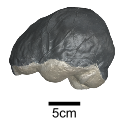















| Plane | Position | Flip |
| Show planes | Show edges |
0.0
M3#972
The frontal region of the endocast is flattened, probably formed by the constant pressure on the frontal bone during growth. There is a well-developed frontal crest on the endocranial surface. The endocast widens posteriorly from the frontal lobe. The widest point of the endocast is at the lateral border of the parietal lobe. The lower parietal areas display a marked lateral expansion. The overall shape of the endocast is asymmetrical, with the left side of the parietal lobe being more laterally expanded than the right side. Like the frontal lobe, the occipital lobe is also anteroposteriorly flattened.
Data citation:
Yin Qiyu , Li Qiang
, Ma Ming
, Zhang Wei
and Ni Xijun
, 2022. M3#972. doi: 10.18563/m3.sf.972
Model solid/transparent

|
The endocranial cast of a 10 ka intentionally deformed human cranium from ChinaYin Qiyu, Li Qiang, Ma Ming, Zhang Wei and Ni XijunPublished online: 27/07/2022Keywords: endocranial cast; intentional cranial deformation; Northeast China https://doi.org/10.18563/journal.m3.169 Abstract This contribution contains the 3D model of an endocranial cast analyzed in “A 10 ka intentionally deformed human skull from Northeast Asia”. There are many studies on the morphological characteristics of intentional cranial deformation (ICD), but few related 3D models were published. Here, we present the surface model of an intentionally deformed 10 ka human cranium for further research on ICD practice. The 3D model of the endocranial cast of this ICD cranium was discovered near Harbin City, Province Heilongjiang, Northeast China. The fossil preserved only the frontal, parietal, and occipital bones. To complete the endocast model of the specimen, we printed a 3D model and used modeling clay to reconstruct the missing part based on the general form of the modern human endocast morphology. M3 article infos Published in Volume 08, issue 03 (2022) |
|